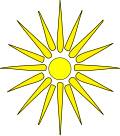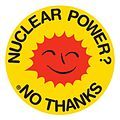Sun symbol
A sun symbol is a symbol that symbolizes the sun . Sun symbols can have meaning in psychoanalysis , symbolism , semiotics , astrology , religion , mythology , mysticism , divination , heraldry, and vexillology , among other areas.
Circle symmetry
circle
A simple circle or circular disk can be a symbol of the sun, as in the flag of Japan , the flag of Bangladesh , the Australian flag of the Aborigines , or three-dimensional as part of the Trundholm sun chariot .
Circle with a point in the middle
This is an ancient sun symbol, consisting of a circle, the center of which is marked by a point (preferably Unicode U + 2609 ☉, or U + 2299 22). It is the astronomical and astrological symbol of the sun, and the ancient Egyptian symbol for "sun" or " Ra " in the hieroglyphic writing system (U + 131F3, ?). The character for "sun" or "day" in older Chinese writing systems was similar, but it became square in the modern writing system: 日 ( ri ).
(See Circled Dot for non-sun related meanings.)
Quadruple rotational symmetry
Sun cross
For the "sun cross" or "sun wheel" (⊕) it is often assumed that it represents the four seasons and the tropical year and thus the sun (although it denotes the earth as an astronomical symbol ).
swastika
The swastika can be derived from the sun cross and is another sun symbol in some contexts. It has uses (not necessarily as a sun symbol) among Buddhists (manji), Jainists , Hindus and many other cultures.
Armenian eternity sign
The Armenian sign of eternity is one of the ancient Armenian symbols of eternity and light. It is often used as a decoration on non-Christian monuments and on Armenian cross stones. Variants with different numbers of petals and different directions of rotation are in use in Armenia.
Zia sun symbol
The people of Zia in New Mexico sees the sun as a sacred symbol. Their symbol, a red circle with four groups of four each pointing in one direction, is painted on ceremonial vases, drawn on the floor around campfires and used to introduce newborns to the sun. The red symbol is shown here on the flag of New Mexico .
Eight-pointed star

Different shapes of an eight-pointed star (which usually have only fourfold rotational symmetry) appear on the flags of various Russian republics with sun-related meaning - for example, Udmurtia , Mordovia , Mari El and Chuvashia - and had a similar meaning on the flag of Iraq from 1959–1963 . It is an ancient symbol of the Urals tribes. An example of a sixteen-fold symmetrical star can be seen on the flag of Cartagena de Indias ( Colombia ).
Doubled sun cross
Another version of the "sun cross", in the shape of an eight-spoke wheel (not related to many of the wheel symbols used in heraldry at the time ). These can be understood as marking the cross-quarter days (middle of the seasons) together with the spokes marking the conference equinoxes and solstices.
Polish sun symbol
Polish neo-pagan sun symbol, similar to the tomoe or swastika.
Triple rotational symmetry
Triskele
Some forms of the triple spirals or triskeles are seen as symbols of the sun.
Wainachian sun symbol
The flag of Ingushetia shows the sun symbol of the Wainache , a variant of the triskele, consisting of a closed circle in the middle with three attached outwardly curved arcs.
Sixfold rotational symmetry
Sun circle
Slavic sun symbol, present on the idol of Sbrutsch as a symbol of Svantovite , the Slavic god of war.
Alpine sun
The Alpine sun is a symbol based on the model of decorative elements found on houses in northern Italy, which is used by the Lega Nord and similar organizations in northern Italy .
rosette
As a Slavic sun symbol, this shape is a sign of Perun (the Slavic Jupiter ) and a common decorative element. The shape can be found in the Carpathian sun , the logo of Towarzystwo Karpackie (Carpathian Society ), which is committed to nature and culture in the Carpathian Mountains . The shape is similar to the flower-of-life pattern.
Representations with rays

A circular disk with alternating triangular and wavy rays emanating from it is a common symbol or a common artistic representation of the sun. There are at least four straight and four wavy rays (as in the ancient Mesopotamian symbol of the sun god Šamaš ), but there are also higher numbers. The emblem of the Jesuits , the Flag of Uruguay , the Flag of Kiribati , some versions of the flag of Argentina , the badge of the Irish Armed Forces and the State Emblem of Iraq 1959-1965 are official official characters that use such symbolism.
The illustrations of the sun on the flag of the Republic of China , the flag of Kazakhstan , the flag of Kurdistan, and the flag of Nepal have only straight (triangular) rays, while the flag of Kyrgyzstan has only curvy rays. The flag of the Philippines has short diverging rays in groups of three.

Another form of representation with rays consists of simple radial lines that divide the field into two colors, as in the military flag of Japan ( Kyokujitsuki , Japanese 旭日 旗, "flag of the rising sun") and the flag of North Macedonia , and in the upper parts the flag of Tibet and the flag of Arizona .
Vergina sun
The Sun of Vergina (also known as the Star of Vergina, Macedonian Star, or Argead Star ) is a radiant sun symbol that appeared in ancient Greek art from the 6th to 2nd centuries BC. The sun of Vergina appears differently in art with sixteen, twelve or eight triangular rays.
Laughing sun
The laughing sun has been used as a logo by the anti-nuclear movement since the 1970s. It symbolizes positive energy and the use of solar energy and other renewable energies instead of nuclear energy .
Shamanism
Some of the drums of Sami shamans have the Beaivi sun symbol, which resembles a sun cross.
See also
- Astronomical symbol
- Belak
- National emblem of the Republic of China
- Black sun
- Monad (Greek philosophy)
- Sun cult
- Sun cross
- Sun (heraldry)
- Sol de Mayo
- symbolism
- Behdeti (winged sun)
Web links
- Origins and Meanings of the Eight-Point Star. Moroccan design, March 24, 2008, archived from the original on September 24, 2015 ; accessed on November 10, 2015 .
- Sun tattoos - The sun in tattoo art.
Individual evidence
- ^ Rudolf Koch : The drawing book , Leipzig 1936, p. 23.
- ^ Ottfried Neubecker : Heraldry: Sources, Symbols, and Meaning. McGraw-Hill, New York 1976, p. 142.
- ↑ Айк Демоян: "Армянские национальные символы" = "Հայկական ազգային խորհրդանշաններ". Пюник, Ереван 2013, ISBN 978-9939-0-0282-8 .
- ^ Slavic symbolism and its meaning. slavorum.org, September 4, 2014, accessed May 6, 2016 .
- ^ Declaration of the Carpathian Society. Towarzystwo Karpackie (Carpathian Society), accessed on November 9, 2015 .














